There is a cetificate and original.xml
when I try to sign full part of this xml(set url in Reference as ""), I can get the same result in C# and java.
but when I try to sign part of this xml. The SignatureValue is different in java and C#.

 the
the previous one is signed by C#, the next one is signed by java
the
the previous one is signed by C#, the next one is signed by java
here is my core code in C#
public static void SignXml(XmlDocument Doc, X509Certificate2 certificado)
{
if (Doc == null)
throw new ArgumentException("Empty XML Document Object ?");
// Estou verificando se o certificado xml é nulo
if (certificado == null)
throw new ArgumentException("Empty certificate ?");
// Variavel do tipo string que recebe a URI padrão para criação do elemeto de assinatura digital XML.
string digestMethod = "http://www.w3.org/2000/09/xmldsig#sha1";
// Variavel do tipo string que recebe a URI padrão para criação do elemeto de assinatura digital XML.
string signatureMethod = "http://www.w3.org/2000/09/xmldsig#rsa-sha1";
// Variavel do tipo string que recebe a chave do Ct-e que será usada como URI de referencia para assinatura.
string chaveCTE = "#CTe35220542584754000267570010011557921761246837";
// Classe responsavel para realizar a assinatura do XML.
SignedXml signedXml = new SignedXml(Doc);
// Passamos a chave privada do certificado.
signedXml.SigningKey = certificado.PrivateKey;
// A classe recebe informaçoes padroes da assinatura.
signedXml.SignedInfo.SignatureMethod = signatureMethod;
// Criamos uma referencia para a assinatura, carregamos ela com a chave do CT-e e o padrão de elemento de assinatura digital
Reference reference = new Reference()
{
Uri = chaveCTE,
DigestMethod = digestMethod
};
// Adicionamos uma transformação enveloped à referencia.
XmlDsigEnvelopedSignatureTransform env = new XmlDsigEnvelopedSignatureTransform();
reference.AddTransform(env);
//XmlDsigC14NTransform c14Transform = new XmlDsigC14NTransform();
//reference.AddTransform(c14Transform);
// Adicionamos a referência ao objecto SignedXml.
signedXml.AddReference(reference);
KeyInfo keyInfo = new KeyInfo();
keyInfo.AddClause(new KeyInfoX509Data(certificado));
signedXml.KeyInfo = keyInfo;
// Assinamos.
signedXml.ComputeSignature();
// Extraimos a representação da assinatura em XML
XmlElement xmlDigitalSignature = signedXml.GetXml();
// Juntamos a assinatura XML ao documento.
Doc.DocumentElement.AppendChild(Doc.ImportNode(xmlDigitalSignature, true));
}
here is my code in java
(refer from here)
public static Document signAssertion(Document doc, SAMLKeyStore samlKeyStore) throws Exception {
// Instance main XML Signature Toolkit.
XMLSignatureFactory fac = XMLSignatureFactory.getInstance("DOM");
XPathFactory xPathfactory = XPathFactory.newInstance();
// Retreive PrivateKey and Public Certificate from Specified KeyStore.
PrivateKey privateKey = samlKeyStore.getPrivateKey();
X509Certificate publicCertificate = samlKeyStore.getPublicCertificate();
// Retreive Assertion Node to be signed.
XPath xpath = xPathfactory.newXPath();
XPathExpression exprAssertion = xpath.compile("//*[local-name()='Response']//*[local-name()='Assertion']");
Element assertionNode = (Element) exprAssertion.evaluate(doc, XPathConstants.NODE);
// Must mark ID Atrribute as XML ID to avoid BUG in Java 1.7.25.
assertionNode.setIdAttribute("ID", true);
// Retreive Assertion ID because it is used in the URI attribute of the signature.
XPathExpression exprAssertionID = xpath.compile("//*[local-name()='Response']//*[local-name()='Assertion']//@ID");
String assertionID = (String) exprAssertionID.evaluate(doc, XPathConstants.STRING);
// Retreive Subject Node because the signature will be inserted before.
XPathExpression exprAssertionSubject = xpath.compile("//*[local-name()='Response']//*[local-name()='Assertion']//*[local-name()='Subject']");
Node insertionNode = (Node) exprAssertionSubject.evaluate(doc, XPathConstants.NODE);
// Create the DOMSignContext by specifying the signing informations: Private Key, Node to be signed, Where to insert the Signature.
DOMSignContext dsc = new DOMSignContext(privateKey, assertionNode, insertionNode);
dsc.setDefaultNamespacePrefix("ds");
// Create a CanonicalizationMethod which specify how the XML will be canonicalized before signed.
CanonicalizationMethod canonicalizationMethod = fac.newCanonicalizationMethod(CanonicalizationMethod.EXCLUSIVE, (C14NMethodParameterSpec) null);
// Create a SignatureMethod which specify how the XML will be signed.
SignatureMethod signatureMethod = fac.newSignatureMethod(SignatureMethod.RSA_SHA1, null);
// Create an Array of Transform, add it one Transform which specify the Signature ENVELOPED method.
List<Transform> transformList = new ArrayList<Transform>(1);
transformList.add(fac.newTransform(Transform.ENVELOPED, (TransformParameterSpec) null));
// Create a Reference which contain: An URI to the Assertion ID, the Digest Method and the Transform List which specify the Signature ENVELOPED method.
Reference reference = fac.newReference("#" + assertionID, fac.newDigestMethod(DigestMethod.SHA1, null), transformList, null, null);
List<Reference> referenceList = Collections.singletonList(reference);
// Create a SignedInfo with the pre-specified: Canonicalization Method, Signature Method and List of References.
SignedInfo si = fac.newSignedInfo(canonicalizationMethod, signatureMethod, referenceList);
// Create a new KeyInfo and add it the Public Certificate.
KeyInfoFactory kif = fac.getKeyInfoFactory();
List x509Content = new ArrayList();
x509Content.add(publicCertificate);
X509Data xd = kif.newX509Data(x509Content);
KeyInfo ki = kif.newKeyInfo(Collections.singletonList(xd));
// Create a new XML Signature with the pre-created : Signed Info & Key Info
XMLSignature signature = fac.newXMLSignature(si, ki);
signature.sign(dsc);
// Return the Signed Assertion.
return doc;
}
Thanks!